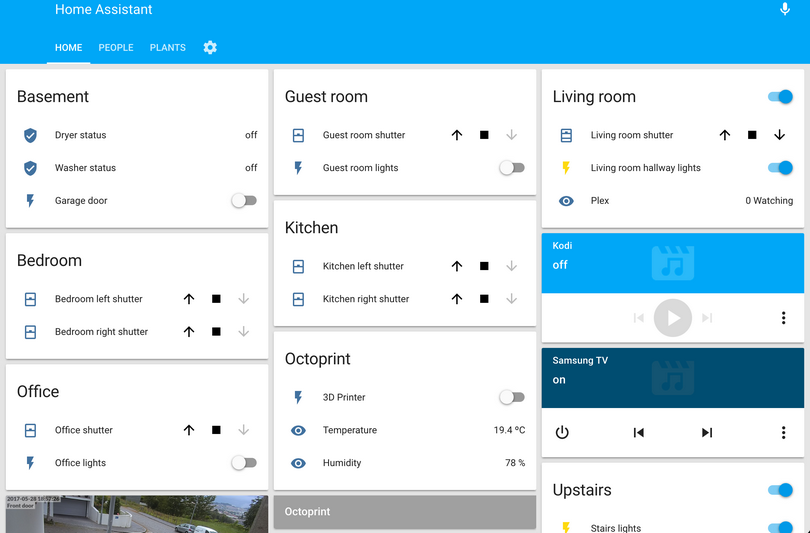 Versie 0.93 Home Assistant is uitgebracht. Home Assistant is een opensourceplatform voor home-automation dat draait onder Python 3. Het draait via Hassbian op een Raspberry Pi 3 of een Linux-, macOS- of Windows-computer. Het ondersteunt het detecteren van apparaten, zoals Nest-thermostaten, Philips Hue, Belkin WeMo-schakelaars, Mr. Coffee-koffiezetapparaten, de slimme schakelaars van IKEA en het mqtt-protocol. Daarnaast kan het waar mogelijk deze apparaten aansturen en automatisering toepassen. Voor meer informatie verwijzen we naar deze pagina en ons Forum. De releasenotes voor deze uitgave zijn hieronder te vinden.
Versie 0.93 Home Assistant is uitgebracht. Home Assistant is een opensourceplatform voor home-automation dat draait onder Python 3. Het draait via Hassbian op een Raspberry Pi 3 of een Linux-, macOS- of Windows-computer. Het ondersteunt het detecteren van apparaten, zoals Nest-thermostaten, Philips Hue, Belkin WeMo-schakelaars, Mr. Coffee-koffiezetapparaten, de slimme schakelaars van IKEA en het mqtt-protocol. Daarnaast kan het waar mogelijk deze apparaten aansturen en automatisering toepassen. Voor meer informatie verwijzen we naar deze pagina en ons Forum. De releasenotes voor deze uitgave zijn hieronder te vinden.
0.93: Essent, AmbiClimate, VS Code debuggingIt’s time for our 0.93 release and it is a whopping cool one. It’s a day later than usual as I am travelling. Frenck streams his work on Home Assistant / Hass.io each Tuesday and Friday, and last Tuesday I decided to surprise him and visit his house during the stream 😛. We ended up talking about everything Home Assistant with the viewers for over 3 hours. For the full conversation, check out Frenck’s blog. Clip of me walking into the stream:
Last week we also wrote about our updated plans for Home Assistant for this year. If you haven’t read it yet, worth the read!
If you are a Nest user, we have some sad news: Google announced that they are shutting down the Nest API at the end of August. This will cause Nest hardware to no longer work with Home Assistant (╯°□°)╯︵ ┻━┻
As always, this release is accompanied by a new episode of the Home Assistant podcast. Rohan and Phil discuss the new release, the Nest API and a lot more. This episode is their 50th episode already, congratulations on this milestone!
Pascal has updated the way we are building Hass.io. It is now keeping the build up to date while we develop Home Assistant, which means that the Hass.io build was ready before the release blog post was up!
Home Assistant 1.0As we mentioned in our updated plans post, we’re working hard on Home Assistant 1.0. Over the next releases we will work on polishing the UI, the backend architecture, and everything in between.
One of the new things that we introduced is a new step in our onboarding allowing users to set up integrations. We will automatically highlight discovered integrations. Once the user finishes the onboarding flow, entities will be automatically grouped by the areas that they are in. Neat!
We’ve also been working on polishing parts of our config UI. The automation editor will now show all automations, the last time they got triggered, and allow users to enable/disable them.
SonosThe Sonos integration has a number of changes in this release, some of them breaking existing configuration.
First, the Sonos custom services have been moved to the sonos domain. The new service names are as follows:
- sonos.join (before: media_player.sonos_join)
- sonos.unjoin (before: media_player.sonos_unjoin)
- sonos.snapshot (before: media_player.sonos_snapshot)
- sonos.restore (before: media_player.sonos_restore)
- sonos.set_sleep_timer (before: media_player.sonos_set_sleep_timer)
- sonos.clear_sleep_timer (before: media_player.sonos_clear_sleep_timer)
- sonos.update_alarm (before: media_player.sonos_update_alarm)
- sonos.set_option (before: media_player.sonos_set_option)
The last four of those services no longer target all entities by default since that is usually a mistake. The entity_id attribute is thus becoming mandatory for those services. If you really do want to target all you can use entity_id: all.
Next, YAML configuration of Sonos under the media_player: key is no longer accepted. While auto-configuration through the Integrations UI is now the preferred way, static configuration can still be specified under a sonos: key, for example:
sonos: media_player: hosts: - 192.0.2.25 - 192.0.2.26For those of you that like to power down your Sonos, Home Assistant should now handle that without logging errors. Also, speakers that are powered on will be added to Home Assistant without needing a restart.
New IntegrationsNew Platforms
- Adds Orange Pi GPIO platform (@pascallj - #22541) (orangepi_gpio docs) (new-integration) (new-platform)
- Essent sensor (@TheLastProject - #23513) (essent docs) (new-integration) (new-platform)
- Ptvsd debugger component. (@Swamp-Ig - #23336) (ptvsd docs) (new-integration)
- Ambiclimate (@Danielhiversen - #22827) (ambiclimate docs) (new-integration) (new-platform)
- Add Intergas InComfort Lan2RF gateway (@zxdavb - #23736) (incomfort docs) (new-integration) (new-platform)
- Adds Orange Pi GPIO platform (@pascallj - #22541) (orangepi_gpio docs) (new-integration) (new-platform)
- Added component named switcher_kis switcher water heater integration. (@TomerFi - #22325) (switcher_kis docs) (new-platform)
- MQTT Vacuum State Device (@pszafer - #23171) (mqtt docs) (new-platform)
- Add new nextbus sensor (@ViViDboarder - #20197) (nextbus docs) (new-platform)
- Add sensor support for dyson 2018 models (@etheralm - #22578) (dyson docs) (new-platform)
- Add Bizkaibus, Biscays (Spain) bus service component (@UgaitzEtxebarria - #22934) (bizkaibus docs) (new-platform)
- Added new binary sensor meteoalarm to get weather alerts in Europe (@rolfberkenbosch - #23663) (meteoalarm docs) (new-integration) (new-platform)
- Add water_heater to geniushub, bump client library (@zxdavb - #23384) (geniushub docs) (new-platform)
- New cover platform for ADS integration (@carstenschroeder - #23377) (ads docs) (new-platform)


:fill(white):strip_exif()/i/2006976478.jpeg?f=thumbmedium)